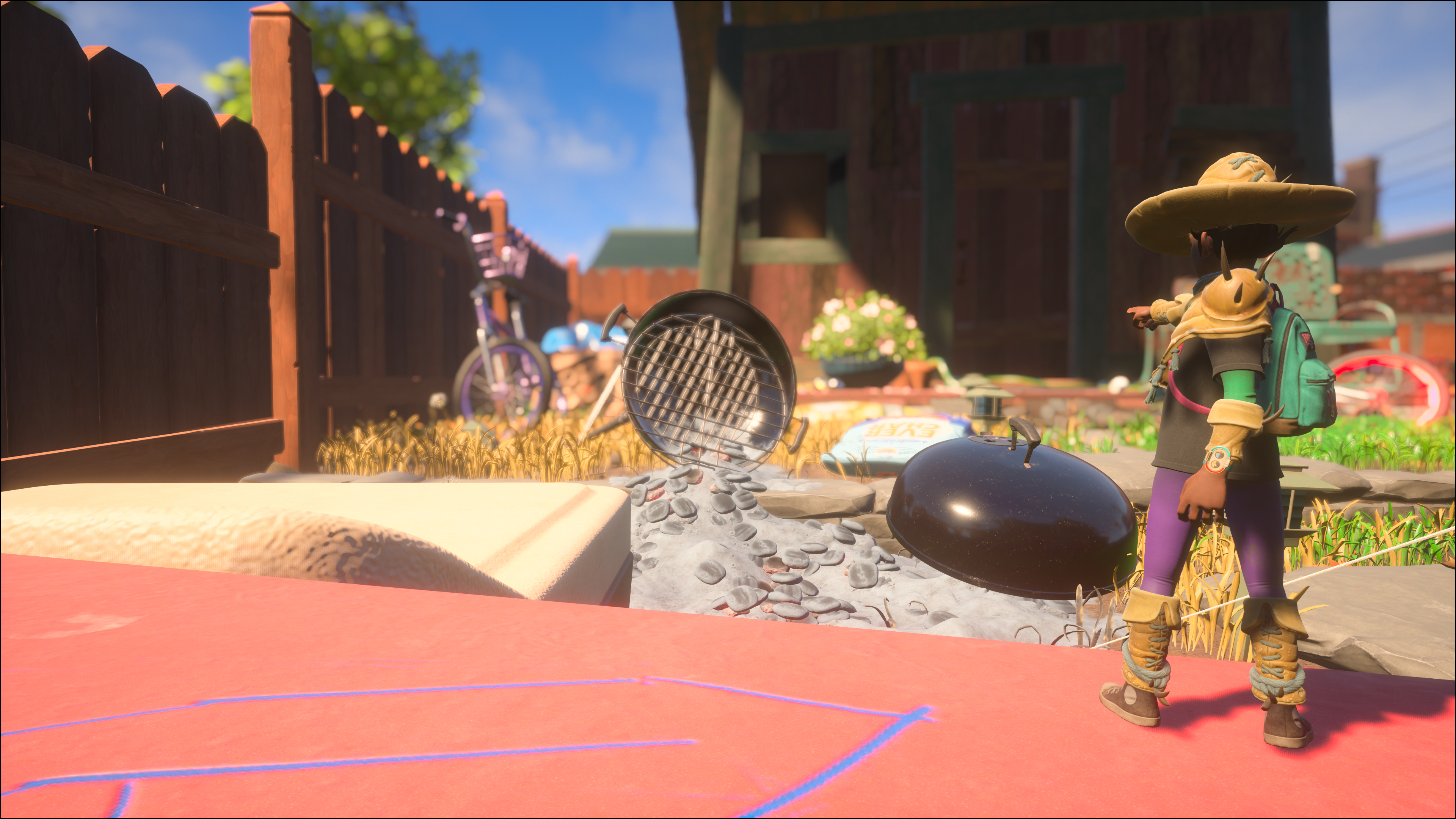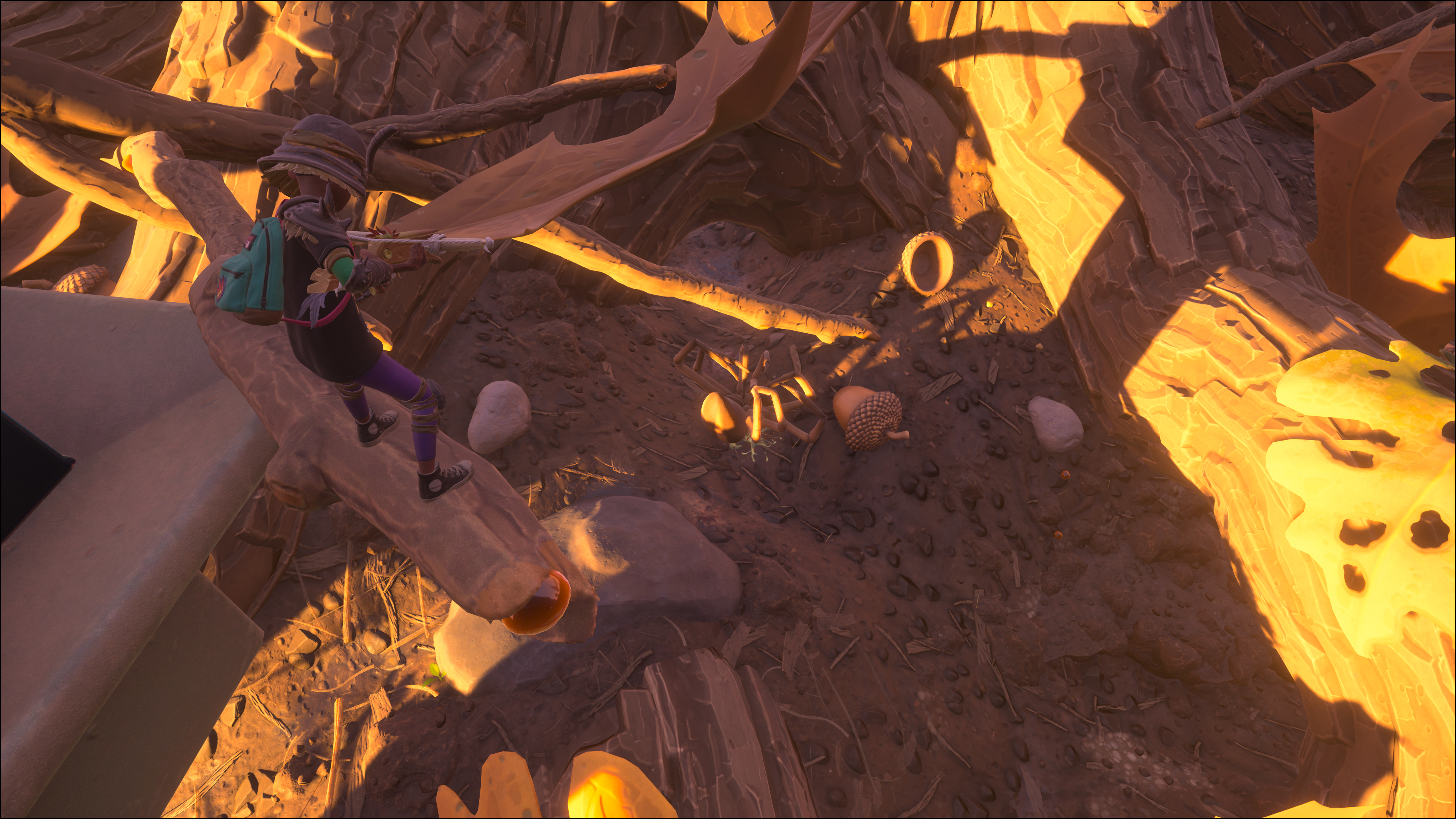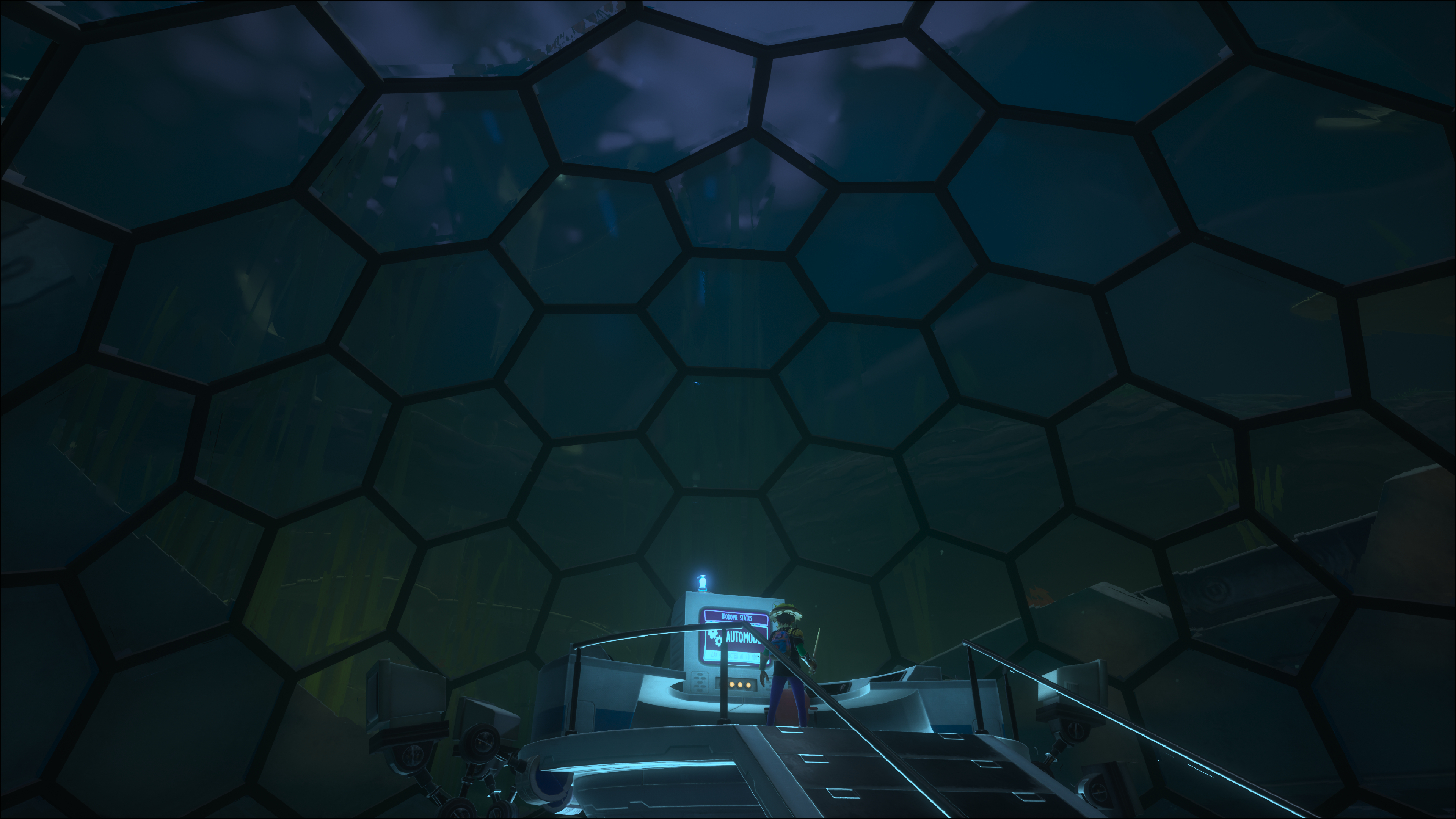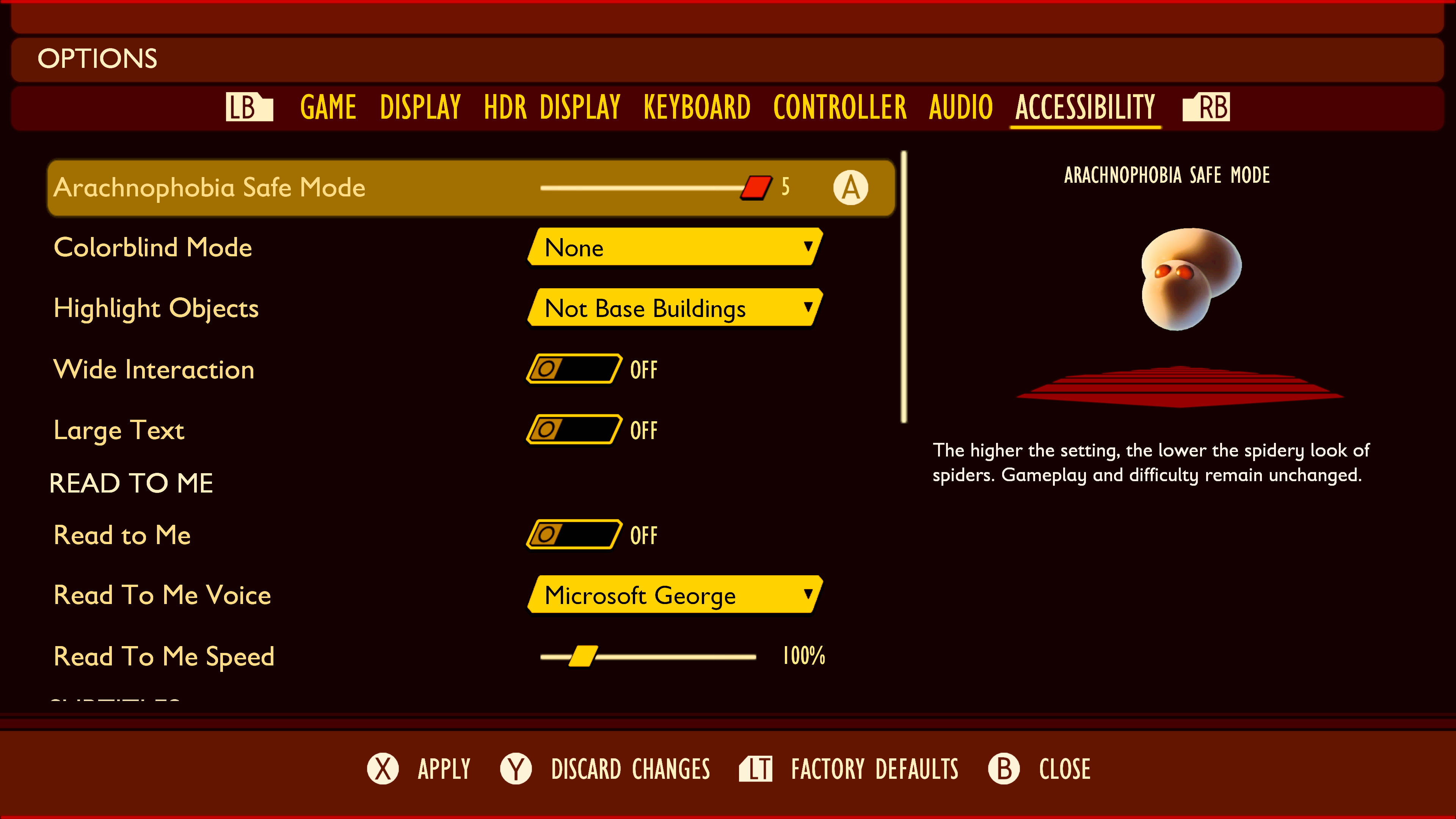For millions of players, Grounded is not a mystery; it’s a known quantity that has steadily grown and evolved over the last two years in early access. However, the final update brings the game out of early access and bestows upon it the vaulted “1.0” version number. This is more than declaring the game “complete” and weaving in the last threads of the story; Grounded’s Backyard is now whole with the massive Upper Yard area, resplendent with new creatures, bosses, locations, and secrets.
The premise behind Grounded is deceptively simple: you’re a teenager, bereft of your memory, lost in a seemingly average suburban backyard. The catch? You’ve inexplicably been shrunk down to the size of an ant, and you now have to scramble to survive long enough to unravel the mysteries of the Backyard and attempt to find a way home. Everything you do, you do from this minuscule size, bringing you down to eye level with spiders, ladybugs, stinkbugs, ants, bees, and so much more.
I spent just under two weeks with a completed Grounded, and I walked away with a backpack full of amazing gaming memories and an unerring desire to turn around and head straight back to my Xbox for another few hours. Obsidian Entertainment and Xbox Game Studios are delivering one of the most interesting titles of the year with Grounded, which will undoubtedly monopolize millions of players’ attention and time well beyond launch.
Disclaimer: This review was made possible by a review copy provided by Xbox Game Studios. The company did not see the contents of the review before publishing.
Grounded review: Visuals and performance

Your time in Grounded will be spent within the Backyard, a sprawling mass of diverse landscapes, unique environments, and all the life that calls it home. You’re bound to discover abandoned objects that hint at the identity of the Tully family residing in the home beyond the Backyard, already reclaimed by a nature made more terrifying and dangerous by your precarious circumstances.
On Xbox Series X, and even older Xbox consoles, it all looks stunning. Everything in Grounded is rendered with minute details that aid the illusion that you’ve been shrunken down, seeing mundane facets of life from a new perspective. The Backyard’s environments are dense and varied, teeming with overlapping ecosystems and native life and begging to be explored by the player. Grounded isn’t a photo-realistic game by any stretch of the imagination, but its colorful art design is paired with impeccable graphical fidelity and performance.
| Developer | Obsidian Entertainment |
| Publisher | Xbox Game Studios |
| Genre | Open-world survival-adventure |
| Install size | 9.3 GB |
| Players | Singleplayer, 4-player online co-op |
| Playtime | 55+ hours |
| Release date | Sept. 27, 2022 |
| Retail price | $40 |
| Platforms | Xbox Series X|S, Xbox One, PC (Steam, Microsoft Store) |
| Xbox / PC Game Pass | Xbox, PC, Xbox Cloud Gaming |
| Reviewed on | Xbox Series X |
Beyond minor qualms with reflections behaving strangely and some ground textures not withstanding closer inspection, I never once faulted Grounded’s visuals. This is a fantastic-looking game, made all the more interesting by its bizarre and intriguing perspective. Walking beside Ladybugs that dwarf you as they meander through the grass in search of aphids, creeping past sleeping Wolf Spiders nestled in their daytime dens, and avoiding the hungry gaze of buzzing mosquitoes flitting around water all elevate the visual experience.
Despite being developed by a smaller team, Grounded supports the entire suite of current-gen features available on Xbox Series X|S consoles, running at a crisp 4K resolution at a rock-steady 60 FPS (I never once noticed stutters or dropped frames, even with plenty of creatures on the screen). Lighting is excellent with HDR support, quick loading times are smooth, Quick Resume works flawlessly to get you back in the action, and Variable Refresh Rate (VRR) support ensures that even when things do get hectic, you don’t notice performance degradation.
Grounded is a fantastic-looking game, made all the more interesting by its bizarre and intriguing perspective.
I only ever experienced two issues with performance: I encountered two crashes in the middle of gameplay that brought me back to the Dashboard, and there were a handful of times when the “Load” or “Save” screens took longer than expected to display my save files, or in-game physics went awry.
Besides those isolated instances, Grounded always feels smooth and stable. Despite some room for improvement, Grounded is indubitably a finished product with plenty of polish. I only considered the two crashes I encountered to be of any concern, and whatever internal flaw caused them may be resolved by the game’s sizeable day one patch. Grounded is in great condition and certainly no longer feels like an early access product.
Grounded review: Survival gameplay and the open world

Your goal in Grounded, first and foremost, is to survive. To accomplish this daunting task in the Backyard, you’ll need to manage your health, hunger, thirst, and stamina; you’ll need to discover and research all the various resources in the Backyard to craft new gear, tools, and buildings; you’ll need to learn how to combat or handle the army of diverse creatures that roam the yard. Grounded’s survival mechanics run deep, with obvious thought and care poured into every facet to ensure it all interacts well with each other.
Grounded’s world is infested with danger and challenges, and it’s up to you to learn exactly how to live through it all. The game gives you plenty of tutorials and helpful information to get you situated, but before long, you’re left to your own devices to survive. It’s up to you to collect data, learn the systems, explore the world, and slowly become more accustomed to the “survival” half of Grounded’s survival-adventure blend of mechanics. You’ll also have to manage your time and inventory, two unassuming factors that actually have a huge effect on your chances of success in Grounded.
Grounded’s Backyard is meant to make you feel as if you don’t belong.
There are plenty of ways to become stronger in Grounded, from upgrading your gear and tools to higher Tiers (there are three), enhancing that gear with powerful damage augments, unlocking hidden Mutations that grant special abilities, and smashing Milk Molars that can improve your basic stats and functions. Nothing feels broken, unbalanced, or out of place, with each respective progression track reliant on all the others to truly make your character more capable. Of course, you will never feel truly safe or powerful in Grounded.
The Backyard is meant to make you feel as if you don’t belong — as if it’s actively trying to eliminate you — and players are expected to occasionally feel at a loss for what to do next. To this end, Grounded’s survival balancing was almost perfect. I stress “almost” because Grounded’s difficulty felt unforgiving at times, with some unexpected spikes and obfuscated directions for progressing. Obsidian Entertainment did an admirable job juggling so many opposing mechanics and factors, but it didn’t always completely succeed.
Grounded’s open-world setting is partially to blame for these admittedly subjective complaints, but it’s also a core element of Grounded that helps to make it as special as it is. The world lives, breathes, and reacts to players as they move through it. Every type of creature has unique behavioral patterns, and the various aspects of Grounded’s world can interact in strange and wonderful ways.

Fortunately, players can take as much time as they need to learn the secrets of Grounded, which may go a long way toward alleviating the frustration of suddenly hitting an unexpected wall or encountering a particularly challenging obstacle. When Grounded is at its best, it feels constantly rewarding to explore and overcome; when its balancing slips toward “unreasonable,” any stumbling (or cheesy tactics) necessary to squeeze past still feels worth it in the end.
That aforementioned world is what will draw many to Grounded, and on this front, the team at Obsidian Entertainment should be proud of the accomplishment. The Backyard is a masterfully crafted open world with a plethora of diverse environments, from the idyllic hills of the Grasslands and the shadowy heights of the Hedge to the murky depths of the Pond and the alien landscapes of the Upper Yard. There are secrets at every turn and new discoveries to be made around every blade of grass.
Even after over 50 hours in Grounded, I still haven’t come close to seeing everything.
It is fascinating to explore the Backyard and to watch the life within exist and interact with one another. Even after over 50 hours of playing Grounded, I still haven’t seen everything there is to see in the Backyard, and that’s not even considering the innumerable hidden locations, easter eggs, and other secrets that are scattered throughout the landscape. The Backyard is one of my favorite open worlds, and my only complaint is that there isn’t even more.
Grounded’s living world, combined with its in-depth and polished survival gameplay, makes for a fantastic gaming experience. However, this game’s claim to fame, and how it sets itself apart from other competitive titles in the genre, lies in how it weaves a mesmerizing narrative, atmospheric world-building, and a cast of fascinating characters into that open-world survival gameplay loop.
Grounded review: Story and progression

The house to which the Backyard belongs is inhabited by the Tully family, comprised of Dr. Wendell Tully, his wife, and their two children. Tully is an eccentric scientist and inventor, obsessed with his latest project to shrink living things down to the realm of insects and other tiny critters. Funding his project is the appropriately named Ominent Practical Technologies, a megafirm specializing in a wide array of applied sciences.
Where do you fit into this? You’re one of four teenagers that are the latest in a recent string of disappearances from the local high school. Missing your memories and cast into a terrifying world at an impossibly small size, you’ll have to unravel the mystery of how you came to be in the Backyard — now abandoned by the Tullys — and how you can make it back home. While there is a handful of cutscenes and cinematic sequences in Grounded, the majority of its storytelling is more subtle and requires the player to connect dots and fill in missing pieces.
Grounded’s story is augmented by the Backyard itself, which is full of miniature tales and visual storytelling clues.
Grounded’s narrative delivery is impeccable, further enhancing the Backyard’s dynamic atmosphere. To return home, you’ll need to investigate the Backyard and the mysterious machine that rests at its center. In the process, you’ll meet the quirky and humorous robot, BURG.L, who’s all too happy to help you on your quest with all the information they have available to them. Unfortunately, BURG.L’s memory is also compromised, and you’ll need to locate several of Tully’s Labs hidden throughout the Backyard to restore their directories.
Along the way, Grounded’s world, characters, and narrative are built by conversations with BURG.L, a collection of voice tapes left behind by both Dr. Tully and BURG.L, a scattering of official files and documents from the same individuals, and a smattering of other clues and objects potentially sourced from other entities at work in the Backyard. All of it is augmented by the Backyard itself, which is full of miniature tales and visual storytelling clues that share bits and pieces of who the Tully family was and why everything is happening.

The campaign of Grounded is hardly direct, preferring to let the player decide how interested they are in the “whys,” “hows,” and “whos” of this gorgeous, horrifying world. If you prefer to know every secret and every detail, there is plenty to discover in Grounded. Alternatively, it’s possible to progress through the story without worrying too much about the narrative itself, although I personally don’t recommend playing the game this way.
While Grounded’s story is simple at its core, I found it to be well-written, persistently interesting, and assiduously crafted from start to finish. It may not go down as my favorite or the most thought-provoking video game campaign of all time. Still, I loved learning about the Backyard, the Tully family, Ominent Practical Technologies, and everything else in Grounded. I’m looking forward to playing through Grounded’s entire story again, but taking extra care and time to explore every nook and cranny (I, unfortunately, had to rush to complete Grounded in time for this review).
I’m looking forward to playing through Grounded’s story again.
Sadly, it doesn’t always feel seamless or even fairly balanced to progress through Grounded’s story. This issue is heavily connected to my earlier complaints about Grounded’s difficulty spikes or general lack of direction at certain points. This mostly applies to Grounded’s endgame, when you’re approaching the finale and exploring the Upper Yard. I won’t share spoilers, but there are two major moments during this final chapter where I felt frustrated when I realized what I was supposed to do. Injecting additional difficulty into an obstacle to purposefully challenge players differs from something inherently difficult because its game design doesn’t make sense, or you’re limited as one player.
I can’t imagine how much work has been done to perfect Grounded’s flow from beginning to end, and it’s wonderfully designed 98% of the time; Grounded seldom misses the balance between approachability and difficulty. However, the moments when it does certainly linger in my thoughts and prevent me from waxing lyrical without reservation.
I’d be remiss if I didn’t mention — spoiler-free, of course — that the end of Grounded’s campaign hinted that there is additional story content and possibly alternative endings, that I missed in my playthrough. I hardly needed more incentive to replay Grounded with a friend, but I certainly can’t let those mysteries lie without thorough investigation. As a side note, watch the credits and listen to the end credits song, both before and after you finish Grounded. You won’t be disappointed.
Grounded review: Multiplayer and online co-op

The entirety of my time spent with the full version of Grounded was done so solo, with no friends to help me. I’m not able to definitively pass judgment on the game’s multiplayer features in their, hopefully, most polished state. That being said, I spent a lot of time in a multiplayer world with my friend just before I was granted early access to Grounded 1.0, and I certainly have some thoughts.
I had a blast playing Grounded on my own, and it’s absolutely possible. Having done so, though, I’m confident in saying that Grounded is meant to be played with friends (up to four, including yourself) and is at its best when its online co-op features are embraced. Exploration is more rewarding with a companion; combat is more forgiving and engaging with a partner, and building and crafting are more productive with a collaborator. Combat, especially, feels much more reasonable when you play with friends, with many of the game’s more powerful creatures seemingly designed to demolish anyone taking them on solo.
Playing in co-op doesn’t come without compromises, of course. Having to build or craft more of everything is a drain on resources, which is especially noticeable when you begin seeking more valuable or rare materials. Conversely, this is the advantage solo players gain. However you play, Grounded offers a plethora of incredible gaming experiences; next time, however, I’m definitely playing through Grounded alongside my friend.
Grounded is at its best when its online co-op features are embraced.
We’ll be doing so using a unique feature that more co-op games need to employ: Shard Worlds. A feature introduced in the last early access update before Grounded’s 1.0 launch, Shared Worlds allow players to upload a save file to the cloud. Once it’s there, any invited player in that world can join at any moment and play, even if the owner isn’t present. This is essentially a private server, always available to players, and ensures that you can still play even if your friends aren’t able to be on at the same time as you.
During its early access tenure, Shared Worlds were rough around the edges. They frequently went down for maintenance, and we encountered Shared World save files completely disappearing on multiple occasions (those save files mysteriously reappeared only after I gained access to the full game). Since then, though, the Grounded team has put in a lot of work to polish the experience. I’ll have to reserve my final judgment on Shared Worlds until I can experience its completed form myself, but I adore what I’ve seen of this feature and heartily believe it makes an already awesome online co-op game even better and more seamless.
Grounded review: Accessibility and approachability

Xbox is one of the industry’s biggest advocates for the advancement of accessibility and approachability in gaming, and that work shows in Grounded. Obsidian Entertainment has included a ton of granular settings and options in Grounded on top of a solid onboarding experience, which aims to gently introduce players to the Backyard.
As far as accessibility is concerned, I’ll be the first to say that Grounded isn’t the most extensive I’ve seen, but Grounded does offer plenty of accessibility features, including its infamous Arachnophobia Safe Mode to reduce the on-screen presence of spiders. It also has options to make on-screen elements more noticeable or interactable, narration options to read the in-game text, and even translate spoken player chat to text or written player chat to speech. Other highlights include subtitle customization, colorblind options, and individual keybinding for both controller and mouse/keyboard input.
Grounded’s accessibility and approachability will, hopefully, invite more people to play.
Players have a myriad of settings available to them to control the wider Grounded experience, such as nine individual volume sliders for different game elements. When you start a game, you can deviate from the typical three-tiered difficulty settings and build a Custom Game, which lets you customize various characteristics of the game, such as combat, survival mechanics, building, and more (this does disable Achievements, but is a great option for those that want a different or more tailored experience).
Once you’re in the game, Grounded offers plenty of tutorials and opening quests to ease you into the game and help you wrap your mind around what it takes to survive. Grounded doesn’t hold your hand for very long. Still, there’s always plenty of information and data available in the game’s menus if you need a refresher or something that feels unfamiliar. Grounded feels both accessible and approachable, a major success that will, hopefully, invite more people to attempt to play than otherwise would have been possible — including players of differing abilities and circumstances, or players that are distinctly unfamiliar with survival games.
Grounded review: Should you play it?

On its launch day, Grounded is establishing itself as a dominating force in the survival genre, an undeniable success story for Xbox Game Studios, and a positively gargantuan video game packed with an absurd amount of content for players, new and returning, to explore. I spent two weeks with the full version of Grounded, and I was left with an overwhelming urge to begin a new save file and pour over Grounded’s world with a fine-toothed comb, this time with a friend in tow.
The best Xbox games is an extensive list hardly requiring additional company, but Grounded is making room for itself; Grounded doesn’t take up much room, anyways. It’s hard to believe that such a massive game can be contained within such a diminutive install size (and a tiny area, from our human-sized perspective). For those still on the fence, Grounded is also a day one addition to the greatest on Xbox and PC Game Pass, giving subscribers an easy way to dip their toes into the Backyard without committing to the game’s full price tag.
In case you missed it, Windows Central recently had the opportunity to discuss Grounded’s development journey and what comes next for the epic survival-adventure game with director Adam Brennecke from Obsidian Entertainment.
Whether you’re a long-time fan of survival games or are intrigued by the rapidly expanding genre, Grounded is an excellent entry deserving of your time and attention. The 20-strong team at Obsidian Entertainment has crafted this title with care and passion. It shows as you explore the Backyard from an all-new perspective, one of an insignificant insect, lost betwixt blades of grass. The journey to go big and go home is fraught with danger and adventure, and I can’t wait to start exploring again.
Grounded leaves early access with its 1.0 update on Sept. 27, 2022, and is available on Xbox Series X|S, Xbox One, PC on Steam and the Microsoft Store, Xbox and PC Game Pass, and Xbox Cloud Gaming.




